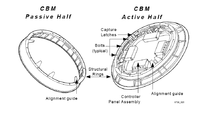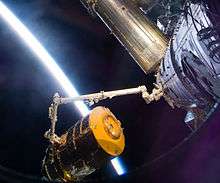Common Berthing Mechanism


The Common Berthing Mechanism (CBM) is a berthing mechanism used to connect all non-Russian pressurized modules of the International Space Station. It was developed by Boeing at the Marshall Space Flight Center (MSFC) in Huntsville, Alabama while under contract to the National Aeronautics and Space Administration (NASA).[1]
A CBM consists of two components: the active common berthing mechanism (ACBM) and the passive common berthing mechanism (PCBM).[1] Once connected, the two sides of the CBM form a pressure tight seal. The CBM also features a hatch, which can be opened to reveal a 50 inch (127 cm) diameter passage for crew/cargo transfer. Since this passage is large enough to allow International Standard Payload Racks to fit, payloads can be pre-configured in racks and transported to the station aboard the Multi-Purpose Logistics Modules, which use CBM ports. Once the hatches have been opened, electrical, data, and fluid lines can be manually connected through the CBM vestibule by the crew.
The first modules in space using the CBM were Unity and the Pressurized Mating Adapters PMA-1 and PMA-2, with all three being launched attached together aboard Endeavour. The first berthing in space using the CBM was the connecting of the Z1 truss to Unity on the International Space Station.[1]
The CBM is used as a berthing mechanism for the unmanned Japanese H-II Transfer Vehicle (HTV), SpaceX Dragon, and Orbital Sciences' Cygnus spacecraft. These spacecraft feature a PCBM, and are berthed to one of the station's open ACBMs using the station's robot arm.[2]
Each CBM compatible module that connects to previously launched modules requires a PCBM to connect to an ACBM.[1] The three ISS connecting nodes feature four radial ACBM ports. Unity features two ACBM on the axial side, while Harmony and Tranquility feature a PCBM on one axial side and an ACBM on the other axial side.[3][4] The Destiny' laboratory and the Japanese Pressurised Module both feature one PCBM and one ACBM.[5][6]
Gallery
 A passive CBM
A passive CBM An active CBM with covers closed
An active CBM with covers closed- Closing of an active CBM's covers
See also
| Wikimedia Commons has media related to Common Berthing Mechanism. |
References
- 1 2 3 4 "The common berthing mechanism (CBM) for International Space Station" (PDF). (923 KiB)
- ↑
- ↑ Gualtieri, N; Rubino, S.; Itta, A. SM98-110/254 International Space Station Node 2 – Structure Design Analysis and Static Test Definition. European Space Agency. p. 174. ISBN 92-9092-712-7.
- ↑ "Node 3 Description" (PDF). NASA.
- ↑ "STS-98 Presskit". NASA. 2001-02-07. Retrieved 2010-02-08.
- ↑ "Pressurized Module:About Kibo – Kibo Japanese Experimental Module". JAXA. 2008-08-29. Retrieved 2010-02-08.
![]() This article incorporates public domain material from websites or documents of the National Aeronautics and Space Administration.
This article incorporates public domain material from websites or documents of the National Aeronautics and Space Administration.